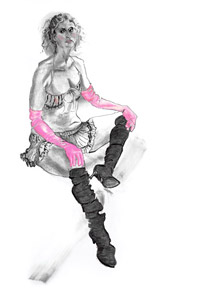
Carol Benisatto: Ladies of the Night and Day
by Ed McCormack
GALLERY & STUDIO Magazine review
April / May 2010
read here

Coco - 24"x36" - mixed media
Carol Benisatto: An Eloquent Delineator of Souls
February 2006 issue of Gallery & Studio
Drawing is the armature on which almost everything else in visual art rests. Thus we are used to thinking of it primarily in terms of preliminary sketches for painting, of which art history has no shortage of sublime examples. But drawing can also be a full-fledged vehicle for finished works, and as such it has its own uniquely expressive characteristics, seen in recent exhibitions at The Drawing Center and elsewhere that have focused on the drawing as a discrete and autonomous artistic entity.
One of the most gifted of the new draftspersons who have been bringing drawing to the forefront in recent years and giving it its rightful due as an art form unto itself is Carol Benisatto, whose solo exhibition can be seen at Viridian Artists @ Chelsea, 530 West 25 Street, from February 7 through 25, with a reception on Saturday February 11, from 3 to 6 PM and an artist's tea on Saturday, February, 18 from 3 to 5 PM.
"My most recent body of work is composed of large format drawings of the figure," Benisatto states. "They could be described as character portraits. They are not caricatures, but employ distortion and exaggeration in a similar way. The process begins with a blind contour drawing of my model. The piece is then developed for the rest of the pose. I start with charcoal, and sometimes tone the paper with powdered charcoal to achieve my goal. Depending on the situation, I may also use pastel, chalk or paint. The end result is a drawing that reflects a heightened sense of the energy, emotion and personality of my sitter."
On encountering Benisatto's drawings, the first forbearers who spring to mind are George Grosz and Alice Neel. Then one realizes that Benisatto's view of humanity is considerably more benign than that of either of those worthy predecessors. Certainly Benisatto is nowhere near as despairing as Grosz, whose experiences as a socialist in prewar Nazi Germany seemed to add acid to his strident ink line and leave him with an attitude toward humanity that lingered like a bad aftertaste, even after he relocated to the United States. By contrast, Benisatto's more relaxed charcoal line suggests an abiding affection for her sitters as it lassos their contours and lingers on their features, lavishing as much attention on an old pair of sneakers as on the human visage. One thinks specifically of her portrait "Wesley," where the man's well-worn New Balance running shoes, their rippling rubber soles expressively delineated in subtle grey tones, occupy the foreground of the composition while the prone figure itself recedes in vanishing perspective and is almost entirely linear.
Here, through her almost reverent treatment of Wesley's cushiony clodhoppers, Benisatto seems to be telling us that a person's clothing can tell us as much about their personality as actual anatomy; that every little detail about a person matters because it reveals something personal and poignant about him or her.
Even a piece of furniture can have a distinct personality in one of her drawings, as seen in "Phoebe," where a plump old sofa seems to embrace the reclining figure of a somewhat portly woman with chopsticks in her hair whose body has the same comfortably lived in quality. In contrast to the contemporary anorexic ideal, the Kate Moss Syndrome so prevalent today, Benisatto seems to prefer bodies that are somewhat less than svelte. She seems set on reviving the idea that bountiful can be beautiful with ample forms that make one think of a latter-day Rubens. And even more important, her figures appear to live richly in the resources of their flesh; they are obviously happy with themselves and exude a life-affirming whole-someness that stands in refreshing contrast to the skin and bones chic of slick, streamlined fashion victims that permeates our mass media.
At the same time, these people have their own more down to earth glamour, personified in "Greta," a portrait of a pensive woman in a short black body suit seated comfortably in midair, apparently on an invisible chair. Here, even more noticeably than in some of her other drawings, Benisatto employs empty space—which is to say, the white of the paper— as an expressive element, played off against the linear contours of the figure, in much the same way that a savvy sculpture animates the air surrounding three-dimensional volumes. In this regard, she has the exquisite spatial sense of those ancient Zen ink painters who created compositional drama by leaving large expanses of the rice or mulberry paper bare.
Such spareness makes Benisatto's line all the more elegant and eloquent in a portrait such as "Collette," which captures a woman in profile wearing a feathered boa (whisked in with lighter-than-air strokes of red pastel) with a swift brevity reminiscent of Toulouse Lautrec at his best, when he was recording his visual impressions of cabaret performers in Montmartre with such casual grace.
In fact, Benisatto seems to have a similarly nonjudgmental, democratic sense of beauty as that great French draftsman, finding it in all sorts of unlikely sitters whose humanity she lays bare with the certainty of a sympathetic surgeon. Thus she gives us a drawing such as "Aileen," which depicts a somewhat eccentric-looking older woman in a black dress and a huge, lacy chapeau encircling her head like a halo or a giant, silken sunflower. Aileen draws back into herself, somewhat suspiciously, as she sits barefoot in her chair. Yet her quiet dignity and her humanity have been preserved beautifully for all to see, attesting to Carol Benisatto's unerring skill in capturing character, even when it is camouflaged by self-consciousness.
—Byron Coleman

